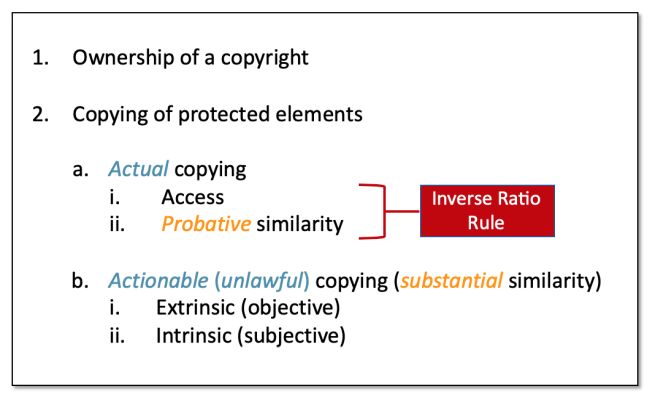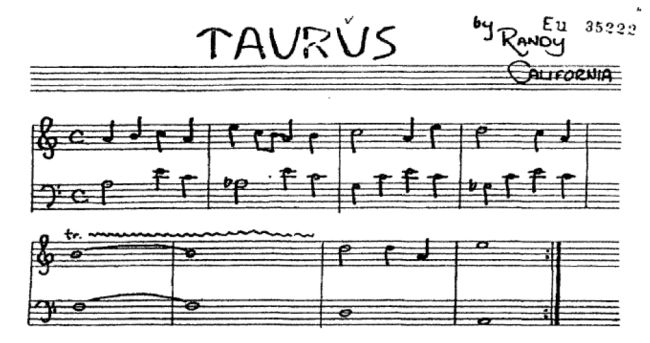Skidmore v. Led Zeppelin - a case about the opening licks of Led Zeppelin's Stairway to Heaven - has been wending its way through courts in the Ninth Circuit for the past six years. We now have an en banc decision that provides an exit ramp for the 14th best band of all time (according to Rolling Stone), and greater clarity for the rest of us about the standards for proving copyright infringement in the Ninth Circuit.
(Very) briefly, here's the background
Randy Wolfe (professionally known as Randy California), a guitarist for the band Spirit, wrote the instrumental song Taurus in 1966 or 1967. The band released the song on its eponymous album in 1967, and Wolfe's publisher registered Taurus for copyright protection as an unpublished work in 1967. The song would become the band's signature song. Stairway to Heaven, written by Jimmy Page and Robert Plant, was released in 1974 on Led Zeppelin's fourth album. There is not a guitar student on earth who hasn't attempted to master the #1 guitar solo of all time (according to Guitar World). Although Led Zeppelin and Spirit likely crossed paths in the late 60s and early 70s, there was no direct evidence that Led Zeppelin ever saw Spirit perform Taurus in concert.
Wolfe died in 1997 (tragically drowning while trying to save his son from a riptide in Hawaii). In 2014 - forty-three after the release of Stairway to Heaven - the Trust that owns the rights to Taurus sued Led Zeppelin (and others), alleging that Stairway to Heaven infringed upon the copyright in Taurus. The jury returned a verdict for Led Zeppelin. In special interrogatories, the jury found that the Trust owned the copyright to Taurus and that Led Zeppelin had access to Taurus, but that the two songs were not substantially similar. A panel of the Ninth Circuit reversed and remanded for a new trial. And now the Ninth Circuit, sitting en banc, has reinstated the original jury verdict in favor of Led Zeppelin.
A lot of ink has been spilled on this case. I want to focus on two important aspects of the latest opinion - the #1 music copyright case (so far) of 2020 (according to me).
1. The Inverse Ratio "Rule" - R.I.P.
On appeal, the Trust challenged the district court's refusal to provide a jury instruction on the inverse ratio rule. The en banc court not only affirmed this holding, but also jettisoned the rule entirely: "[b]ecause the inverse ratio rule, which is not part of the copyright statute, defies logic, and creates uncertainty for the courts and the parties, we take this opportunity to abrogate the rule in the Ninth Circuit and overrule our prior cases to the contrary." (Ooh, it makes me wonder!)
To put the court's ruling in context - and to understand the role played by the inverse ratio rule in copyright infringement analysis - we begin with a quick primer on how courts in the Ninth Circuit (and elsewhere) determine whether one work infringes upon the copyright of another.

To prove copyright infringement, a plaintiff must demonstrate (1) ownership of a valid copyright in the work and (2) copying, by the defendant, of protected aspects of the plaintiff's work. The second prong, in turn, requires the plaintiff to show both that (a) the defendant actually copied the song, and (b) the defendant's copying constituted "unlawful appropriation" (or, to use Nimmer's term, "actionable copying").
Actual Copying. How does one prove actual copying? On rare occasions, there may be eyewitness testimony. (For example, a producer might have testified "I saw Robert Plant suspiciously pouring over the sheet music for Taurus during a cigarette break while recording Stairway." Of course, that never happened.) Rarer still, a defendant may admit to copying. (Imagine Jimmy Page boasting during an interview on The Dick Cavett Show in 1976, "Yeah, we may have taken a note or two from Taurus, but it was an homage!" That didn't happen either.) More typically, actual copying is proven by circumstantial evidence that (i) the defendant had access to the plaintiff's work, and (ii) the two works share similarities probative of "copying rather than ... coincidence, independent creation, or prior common source." (Nimmer calls this "probative similarity.") For purposes of determining probative similarity (and actual copying), the fact finder is permitted to compare elements from the two works that are protectable under copyright and elements that are not - because both flavors of similarities can be indicative of actual copying.
Actionable Copying. If actual copying is proved, the next question is whether there was "unlawful appropriation" (or actionable copying) by the defendant, and this turns on whether the works share "substantial similarities." The Ninth Circuit uses the two-part extrinsic/intrinsic test to determine whether the defendant's work is substantially similar to the plaintiff's. The first (extrinsic) prong requires an objective comparison of the elements that are protectable under copyright law in the two works. Expert testimony (in music cases, typically from musicologists) is permitted to help the fact finder distinguish between protectable and unprotectable elements (such as ideas, public domain elements, and scenes a faire). In the second (intrinsic) prong, the fact finder engages in a subjective analysis and comparison of the two works and examines "similarity of expression from the standpoint of the ordinary reasonable observer, with no expert assistance." The extrinsic prong essentially establishes the boundaries that define the scope of the plaintiff's exclusive rights; the intrinsic prong is intended to determine whether the defendant went too far, took too much, and crossed the boundary of copyright protection established in the extrinsic prong.
The Inverse Ratio Rule. The inverse ratio rule posits that there is an inverse relationship between the strength of the evidence you need of access and of probative similarity. In other words, "the stronger the evidence of access, the less compelling the similarities between the two works need be in order to give rise to an inference of copying." This "rule" was embraced by the Ninth Circuit in 1977, has been followed by the Sixth Circuit, and has been soundly rejected by the Second, Fifth, Seventh, and Eleventh Circuits.
The en banc panel abandoned the rule, and forty years of its precedent, for several reasons.
First, from the beginning, there were problems with the application of the rule. It wasn't even clear, at least initially, whether the rule applied to the actual copying or actionable copying prong of the infringement analysis. (Later, the Ninth Circuit clarified that it applied to the former.) It also wasn't clear how much access was sufficient to tip the balance to make probative similarity less important. These difficulties did not go unnoticed by commentators or even by courts in the Ninth Circuit, and the application of the rule waxed and waned over the years. Based on this unhappy history, en banc court concluded: "The result?—confusion about when to apply the rule and the amount of access and similarity needed to invoke it."
Second, conceptually the rule never made much sense The court cited with approval the Second Circuit's description of the rule as a "superficially attractive apophthegm which upon examination confuses more than it clarifies." Taken to its logical (or illogical) conclusion, the rule suggests that a strong case for access will render a showing of similarities unnecessary. But "it does not follow that 'more' access increases the likelihood of copying." Access is nothing more than an opportunity to infringe. It requires a rather cynical world view to believe - and a leap of logic to conclude - that greater access and opportunity results in a greater likelihood of unlawful infringement. Yet that leap is precisely what the rule requires.
Third, the court noted that "the concept of 'access' is increasingly diluted in our digitally interconnected world," since access can be established readily in cases when the plaintiff's work is available on YouTube, Netflix, Hulu, Amazon, Spotify, Pandora, and other platforms. According to the court, "the inverse ratio rule unfairly advantages those whose work is most accessible by lowering the standard of proof for [probative] similarity."
The court concludes by noting that "[b]y rejecting the inverse ratio rule, we are not suggesting that access cannot serve as circumstantial evidence of actual copying in all cases." In other words, evidence of access and probative similarity can still be sufficient to prove that actual copying occurred. The court also appears to leave intact the line of cases holding that striking similarity - the type of verbatim, literal similarity that is so extensive that any explanation other than copying defies reason - can, in the right case, constitute compelling evidence of actual copying (possibly even when the evidence of access is limited).
2. The Deposit Copy Defines the Scope of Protection Under the 1909 Act for an Unpublished Musical Work
The en banc court also held that, under the Copyright Act of 1909, the scope of copyright protection for an unpublished work is the deposit copy filed with the Copyright Office as part of the copyright application. (Taurus was registered in 1967 - and therefore under the 1909 Act - as an unpublished work.) The court found this conclusion "inescapable" based on the statutory language. Under Section 11 of the 1909 Act, copyright protection for an unpublished work was obtained "by the deposit, with claim of copyright, of one complete copy of such work if it be a ... musical composition" (emphasis added). The twin requirements that the applicant "deposit" a copy of the unpublished work and that such copy be "complete" served important purposes: specifically, "to make a record of the claimed copyright, provide notice to third parties, and prevent confusion about the scope of the copyright." The court also cited the "practical treatment" of deposit copies as a recognition of their importance and additional support for its conclusion, including the 1909 Act's prohibition on the destruction of the deposit copies of unpublished works without notice to the copyright owner (1909 Act, §§ 59–60) and the Register of Copyright's policy to retain access to unpublished works for the full copyright term.
Practically speaking, limiting the scope of protection to the deposit copy creates a formidable challenge for copyright plaintiffs in music cases. Under the 1909 Act, the Copyright Office did not accept a sound recording as a deposit copy; instead, composers were required to submit sheet music. For a host of reasons - including the cost of transcription and the reality that some composers don't read music - deposit copies for compositions can be meagre things, often including only lyrics and the essential elements of the melody. The deposit copy for Taurus is no exception. Here is the eight-measure passage at the beginning of the Taurus deposit copy that allegedly was infringed by Led Zeppelin:

You don't have to be a musicologist to recognize that there is a world of difference between this deposit copy and the musically richer sound recording released by Spirit. (In the court's words, the recording contained "further embellishments.") But because the deposit copy "defines the four corners of the Taurus copyright," similarities between Stairway and the "embellishments" on Spirit's recording of Taurus are irrelevant. It is precisely for this reason that the district court properly denied the Trustee's request to play the sound recording of Taurus in front of the jury or admit it into evidence. instead, the plaintiff was limited to having a master guitarist perform the Taurus deposit copy.
This holding is not a huge surprise given that the original Ninth Circuit panel had reached the same conclusion. (So did the district court in the Blurred Lines case.) Yet, this aspect of the decision is already making waves in other music copyright cases. Take, for example, Griffin v. Sheeren, a case pending in the Southern District of New York where the plaintiffs allege that the song Thinking Out Loud (written by Ed Sheeran) infringes upon Let's Get it On (co-written by Ed Townsend and Marvin Gaye). (See this prior post for some background.) Last week, the district court in that case held (citing Skidmore) that the scope of protection for Let's Get it On is "limited by the deposit copy" and "does not include other embellishments [on Gaye's sound recording] ... because they have not undergone the copyright process." This was true, the court said, even if the embellishments on the sound recording - such Gaye's vocal performance, percussion/drums, bass-guitar, guitars, horns, and flutes - were added by Townsend and Gaye themselves. The court was not persuaded by the plaintiffs' argument that because the "embellishments" on the sound recording were consistent with, and implied, by the sheet music deposit copy, they could properly be considered as within the scope of the plaintiffs' copyright. According to the court, "[i]f what is implied is not in the Deposit Copy, it does not have the protection of copyright." Ultimately, the court ruled that the "Gaye sound recording is inadmissible in any way which might confuse the jury into thinking it represents what is protected by copyright. For example, comparisons of elements in Thinking Out Loud which are similar to elements in the Gaye sound recording (but not the Deposit Copy) will not be allowed."
Skidmore v. Led Zeppelin, __ F.3d __, 2020 WL 1128808 (9th Cir. Mar. 9, 2020).
Griffin v. Sheeran, Case No. 17 Civ. 5221 (LLS) (S.D.N.Y. Mar. 24, 2020).
The content of this article is intended to provide a general guide to the subject matter. Specialist advice should be sought about your specific circumstances.

